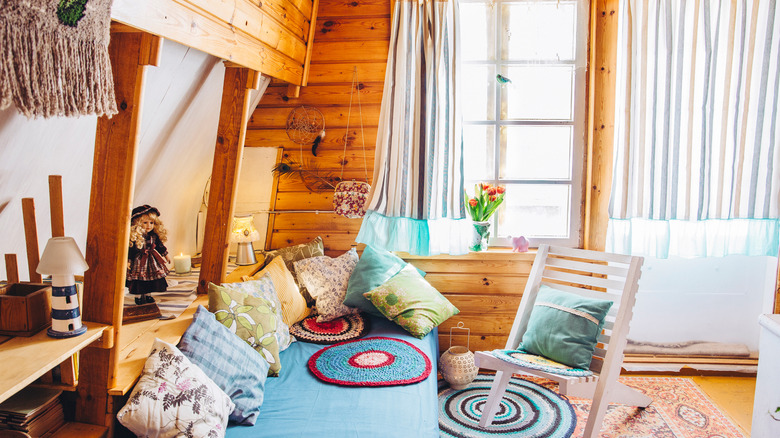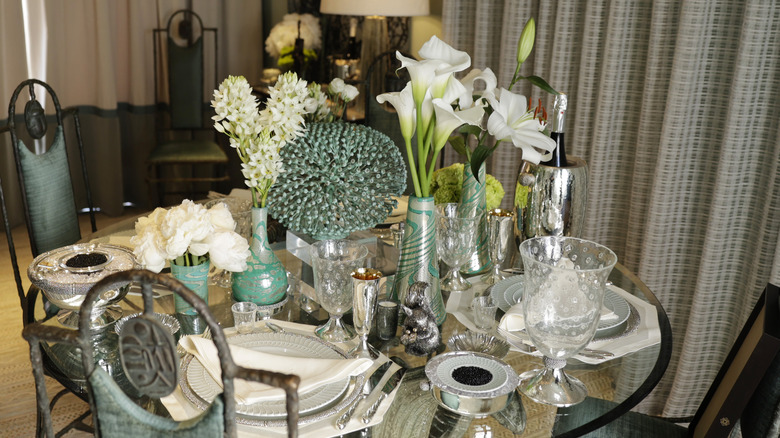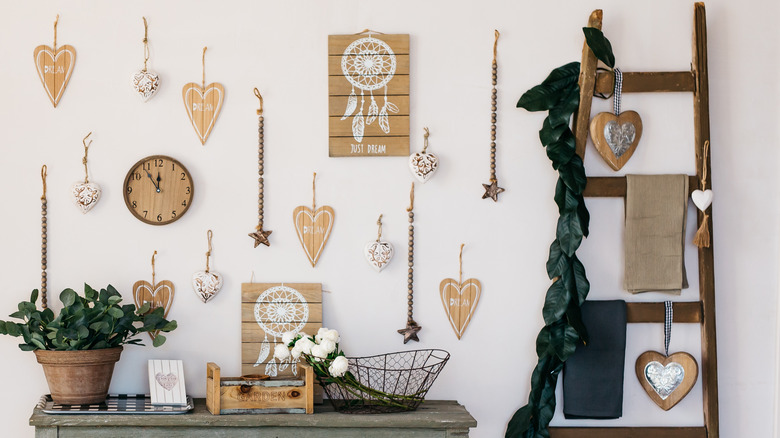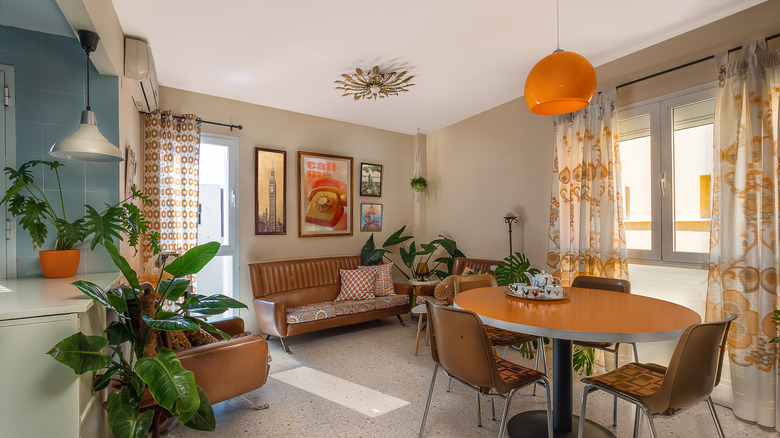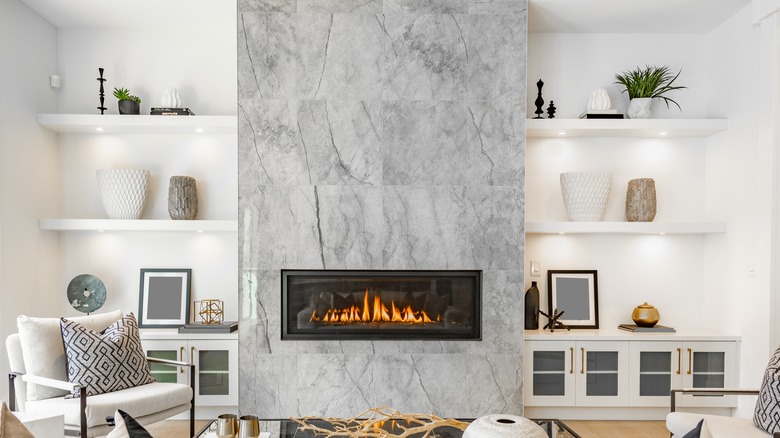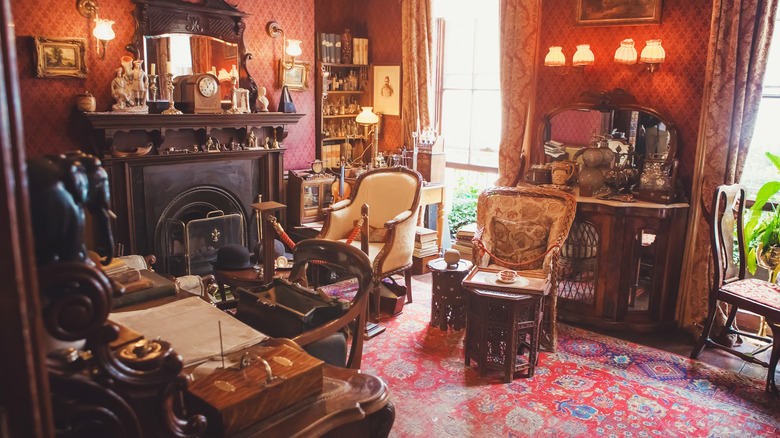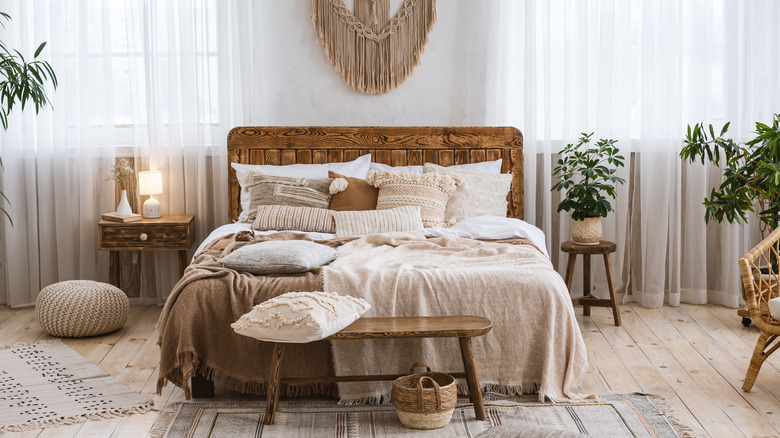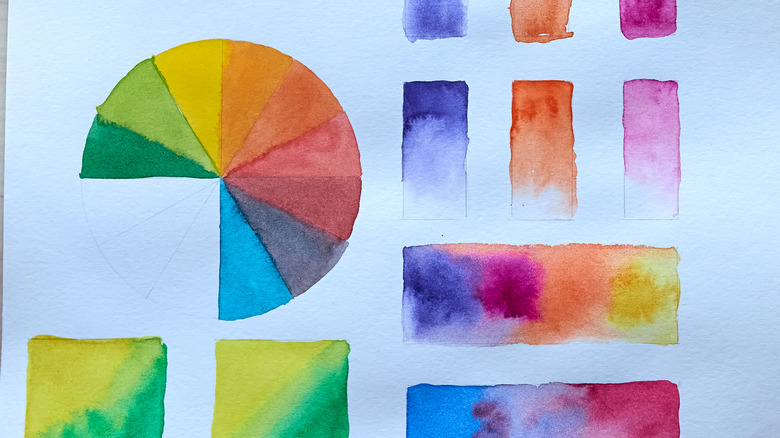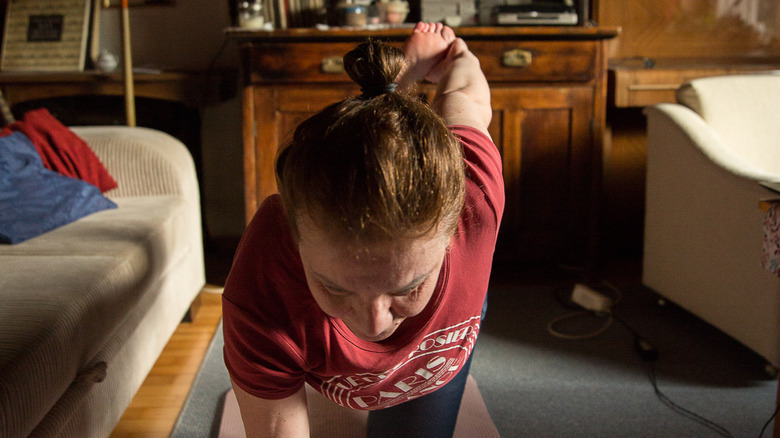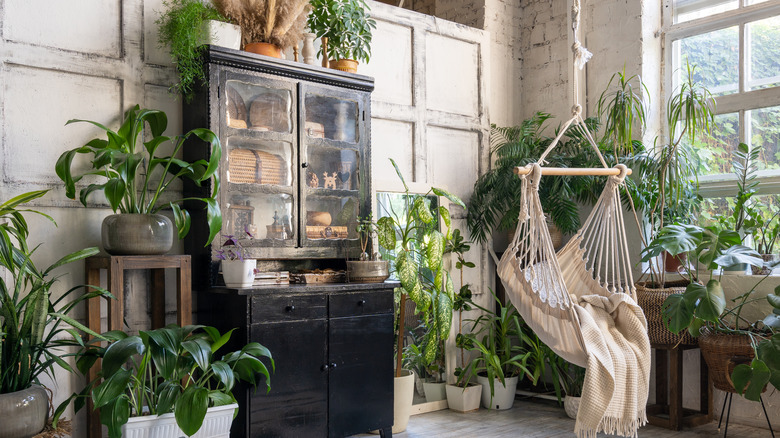The Key Differences Between Maximalism And Cluttercore
Minimalism isn't for everyone, and spending more time at home means stimulating our brains with more pattern, texture, and color. In short, more stuff. According to Living Ect, the new, bold, and over-the-top maximalist-related trend is cluttercore. Unlike maximalism, cluttercore doesn't limit itself necessarily with themes or careful editing. Rather, cluttercore seeks to celebrate the good emotions that our things can bring. It basically encourages you to fill a room with pieces you adore, regardless of whether they match. "Never stop searching, always give in to your curiosity, and if you love something, bring it home. This is invariably a slower method of finding what you need, but once you have it, you'll love it forever," designer Matthew Williamson told the publication.
While maximalism uses bold color and shapes to evoke a certain feeling, cluttercore wants you to have all the joyful feelings you can all at once. Cluttercore uses an exuberant overflow of objects to create a comfortable and homey vibe, while maximalism uses specific layering to bring together a coherent statement (via The Boston Globe).
Maximalism intends to tame our personality into a coherent, relatable style, but cluttercore wants to unleash the wild and jubilant parts of us all in an organized cacophony. Some say this trend offers a similar experience to a crowded antique shop. Here's how the two concepts differ.
Their collections differ in editing
For those who are fond of collecting, maximalism is the style that permits you to show off your beautiful things. However, maximalist rooms require curated collections, whereas cluttercore spaces encourage a cheerful jumble of objects that seem arranged without much forethought. While maximalist collections are carefully edited, tailored, and paired down to create a pleasing balance in the room, cluttercore collections encourage you to find as many pieces as your heart desires, and then display them with abandon around the space. One is pre-planned, and the other is more spontaneous.
Successfully displaying a collection by maximalist standards would have you carefully trace each object in your collection onto paper, cut out the shapes, and tape them up so you can visualize your collection in the space you intend to display it (via Hadley Court). But cluttercore requires more whimsy and spontaneity for the display of treasured objects.
One follows design rules, the other doesn't
Layering with maximalist decor requires adherence to a particular style, color scheme, and form. Robin Baron Design recommends that a maximalist design needs structure to convey the right mood and look; editing is the way to achieve this. Following basic design rules governing balance and patterns are all hallmarks of good maximalist design.
Cluttercore, however, is all about breaking the rules. Structure gives way to emotion, and strict balance gives way to a more malleable idea. While cluttercore should be organized, it doesn't stop for clean lines or space. Rather it embraces some chaos — in a decorative sense — to highlight the best of our stuff. There are no design rules. You won't catch a cluttercore aficionado ruthlessly rearranging a room so colors match, the eye has somewhere to rest, and design styles meld together. They will just as likely clash Victorian with art deco if that's what their instincts tell them to do.
Cluttercore focuses on nostalgia and maximalism focuses on design
While maximalism is a nod to color, texture, and shape, cluttercore revels in the happiness of keeping things you love within reach and keeping your eyes full of the joyful jumble it creates. According to Architectural Digest, cluttercore is designed to evoke good memories, nostalgia, and comfort. How better to do so than with collections that remind us of the good times? Cluttercore is a loud and memory-inspiring answer to minimalism. "I really love watching people embrace the things they love and feel unashamed to externalize it and show it to everyone else," Marianne Eloise, author of "Obsessive, Intrusive, Magical Thinking," told the publication. "When someone comes into my home, they also get a window into who I am and what I like. That's often vulnerable, and kind of cringe when I have to explain to the guy fitting the blinds why I have so many Hello Kitty mugs on the shelf, but I am free."
While maximalism is often considered the polar opposite of minimalism, cluttercore has broken the scale. Conventional design methods or traditional boundaries don't define cluttercore. It's not just about keeping stuff around — it's about proudly and unapologetically displaying stuff just for fun.
They have differing histories
Cluttercore and maximalism come from a similar place and can be traced to previous design trends in history. While cluttercore is a modern invention, the sensibilities of maximalism are seen in different periods as a reaction against minimalism, and have roots in the 1950s and '70s, says Artist.com. The experimentation with color, texture, and shape we experience today can be traced back to those decades.
Often, external world events influence interior design, not just in practical ways, but in emotional ways as well. Maximalism and cluttercore are responses to current events just like their historical counterparts were. The previous maximalist movement in design occurred in the 1950s, signaling a transition away from wartime austerity and towards a more hopeful outlook (via Sonya Winner Design). On the other hand, the pandemic inspired cluttercore to come to the forefront. "People are taking this self-swaddling approach, particularly now," Jennifer Howard, author of "Clutter: An Untidy History," told the BBC. "We want to feel safe, we want to feel comfortable, we want to feel protected and taken care of – stuff can act like a literal cocoon."
Maximalism embraces themes, and cluttercore doesn't
While cluttercore puts your whole life on display, maximalism communicates through a theme. Being able to connect up the riot of colors and shapes sometimes present in a maximalist design with a common theme is part of what makes maximalism unique from cluttercore. According to Audenza, to keep your maximalist design on track, you'll need to draw all of your design elements together with one thread. This technique can be achieved by editing, evaluating your space, and tucking away extras to keep your overall look clean and vibrant.
Cluttercore, on the other hand, relies on the theme of happiness. Cluttercore is the expression of many threads, consisting of all the wonderful objects that feel the best to you. The limits only exist so far as you can extend your shelf space. That's why you'll find Hello Kitty cups next to fine china in a cluttercore house.
Maximalism has roots in modern art
The term maximalism was coined in the 1970s, and like our current interior decorating trend, was a reaction to minimalist art. The Institute of Contemporary Art/Boston traces the roots of maximalism back to a response to modernism and minimalism that were prevalent at the time. Minimalism acted as a display of wealth, but maximalism sought to bring us back to the human side of needing to collect and create.
It sprung from the Pattern and Decoration art movement, and the artists who created it were inspired by many cultures, mediums, and disciplines. It sought to question our artistic traditions, norms, and assumptions and open up creative space for a more comprehensive form of expression. Curator Jenelle Porter told Vice that the art pieces asked, "Why is everything being stripped away? Decoration and ornamentation is very human." You're tapping into that human need for art and creativity when playing with a maximalist aesthetic.
Cluttercore is inspired by Victorians
Cluttercore can arguably trace its origins back to the Victorian era. At the time, mass production was a new phenomenon, and the conspicuous display of trinkets, bobbles, and bric-a-brac was a way for the wealthier class to show off its social position. But there was more to it than just displaying trinkets. Not only did a glass hutch full of baubles tell your guests you had money to spend on frivolous things, but it also implied you had a staff to dust all of those numerous and cluttered possession (via Inverse). This aesthetic can be seen in what we currently refer to as cluttercore, although the motivation is more to communicate a sense of belonging and companionship than wealth.
Rather than trying to impress your guests with how much money you spent on your collections, you're instead trying to invite them into your head and put all of your interests and hobbies on display. It's a bid for connection as much as it is a decor preference.
Cluttercore might affect mental health more than maximalism
To be fair, there are some good reasons people might have for not buying into the cluttercore trend. Although there's no way to draw a line between the cluttered vs. uncluttered life, there is some evidence that too much clutter can harm your mental health. If your clutter is not well organized, or if it spills outside the bounds of your shelves and display surfaces, it can make practical tasks difficult and lead to general disorganization. According to Very Well Mind, excessive clutter can impact your physical and emotional well-being and affect your social life.
If getting rid of things becomes a serious problem, it's no longer a design trend. It's a disorder that needs medical treatment. It's also true that some people just can't concentrate if their space is cluttered. Knowing yourself and your own preferences will help you choose the best design style for you. Maximalism and cluttercore have their drawbacks, so if you love a clean desk and a single, understated decor item, these trends might not be for you.
Maximalism can use color and texture to create a soothing environment
Keeping soft, smooth shapes and gentle, inviting textures at the core of a maximalist design will evoke comfort and hominess. Cluttercore can be cozy in a less specific way, while maximalism uses its strengths in layers and embellishments to create a soothing environment. For instance, according to Veranda, if you want to keep your bedroom tranquil, instead of adding sharply contrasting colors, you can use layered texture on fabric and furniture to create a maximalist aesthetic.
Maximalism often uses different patterns and mismatched prints as part of its overall look. Sticking to rounded shapes and smooth lines are other ways to get a maximalist amount of layers without making a space overly stimulating. Bedding, light fixtures, wallpaper, and window treatments can use texture to create an overall sense of calm. These elements combined with patterns in muted tones can celebrate maximalist excess without keeping you up at night.
The psychology of color
Mixing colors in different ways will cause you to have different emotions. The psychology of color is a tool that interior designers use when trying to create a feeling for a room. Both maximalism and cluttercore design styles use contrast and bold color as design elements. Understanding how these color combinations can affect your mood or state of mind is important when choosing paint, fabric, and flooring. Maximalist design expert Tom Faulkner takes a poetic approach to color, keeping contrast and complementary colors in mind. Cluttercore is all about breaking all the rules, though, even the ones about traditional color psychology (via Metro).
According to The Art Career Project, different colors can be used to draw out different emotions. For instance, warmer colors like red, orange, and yellow can cause excitement, but also sometimes anger. Green can be restful on the eye and the mind as well and is a good color for sleep. Blue is considered to be solid and trustworthy, while purple can convey romance and drama. Making sure you have a handle on the feelings your colors can cause will give you a better sense of what will work in your space.
Multipurpose spaces
There are some practical reasons that cluttercore has made its way onto the scene right now. More and more people are using their homes for work, exercise, creative space, entertainment, and remote video communication. Keeping things at the ready is hard when no one goes far to do anything. YourHomeStyle suggests taking up a hobby to jumpstart your cluttercore decor, and since many of us have done just that recently, it's a perfect fit. As our social lives have been impacted, so too have some of our tastes.
Our living spaces have become more than just a restful place, says Connections by Finsa. They're now our primary sources of fun. Having a good feeling while taking in our space from the sofa now seems more important to people than it might have been a couple of years ago, so our design aesthetic is adapting as we adapt as well. In addition to needing a place for all the elements of our lives that suddenly started happening in our homes, we also need a sense of comfort and pleasure that lends itself more easily to cluttercore design. Since maximalism emphasizes a stricter adherence to themes and color pallets, it's not quite the freeform, lived-in aesthetic that cluttercore embodies.
Form over function
One of the reasons that maximalism and cluttercore are taking hold these days might be that form matters more than function. Instead of utilitarian, bare interiors, both maximalism and cluttercore focus on the visual experience of a room, not just its use. Maximalism can be many colors and textures, but function might be second place to form. Lush fabrics are probably harder to keep clean, but they're just so inviting. So many knick-knacks might be harder to dust, but they look so great. Livspace tells us to keep our aesthetic desires in mind when choosing our decor, and not just focus on our practical needs. While a kitchen should have a place to put your dishes, why can't the cabinets be high gloss enamel? Adding personalization to your practical necessities can allow you to practice maximalism without conceding too much of the functional aspect of your space.
Cluttercore looks at the form vs. function debate and responds with a "form is function" answer. Our things and the comfort they create are just as necessary as a table and chairs. Feeding the soul by keeping and displaying the things that inspire us is the function that cluttercore is after. With minimalism seeming unachievable for many due to the onslaught of stuff we are constantly immersed in, cluttercore is a practical response (via The Conversation).
